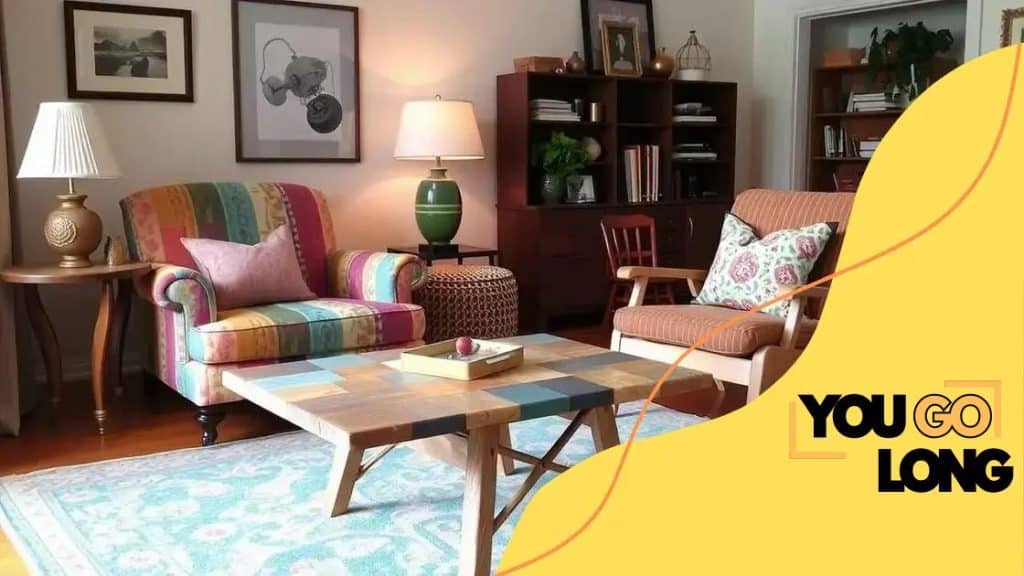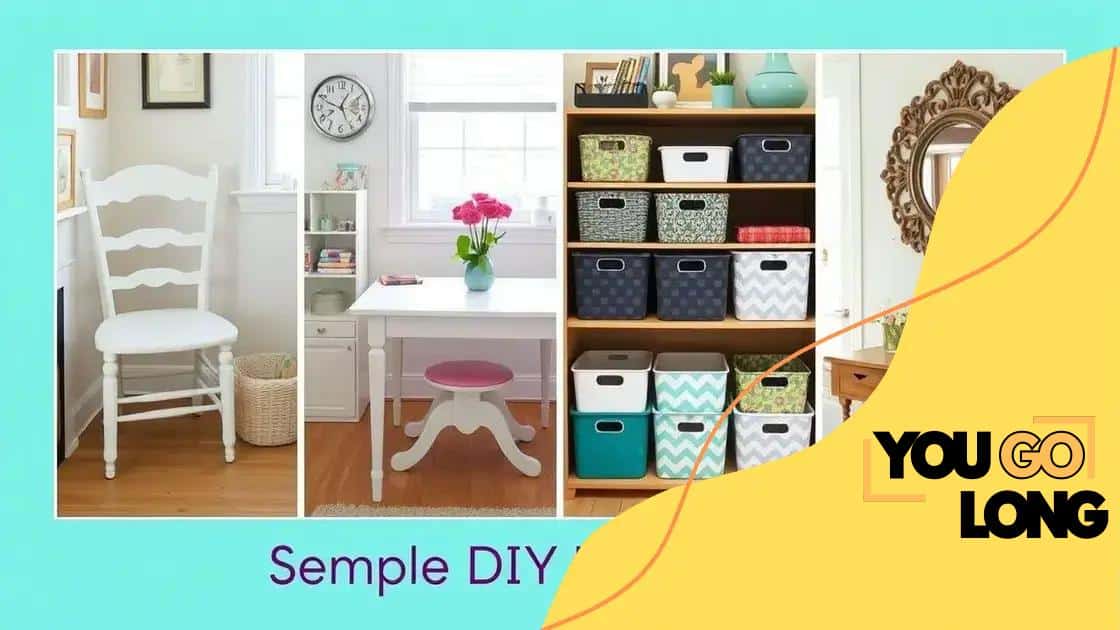Upcycling furniture: Simple DIY projects for beginners

Advertisement
Upcycling furniture involves creatively transforming old or unused pieces into stylish, functional items using basic tools and materials, allowing for a sustainable and personalized home decor.
Upcycling furniture is more than just a trend; it’s a fantastic way to breathe new life into old pieces. Have you ever thought how easy it could be to create something unique for your home? Let’s dive into some simple DIY projects that anyone can tackle!
What is upcycling furniture?
Upcycling furniture is the process of transforming old or discarded furniture into something new and useful. This creative practice allows you to add a personal touch to your home while being environmentally friendly. By giving new life to unwanted furniture, you can express your style and reduce waste.
Understanding Upcycling
Unlike traditional recycling, which breaks down materials to make new products, upcycling keeps the original item intact while improving its appearance or functionality. This means you can turn a worn-out chair into a stylish accent piece or an old table into a unique art installation.
Advertisement
Benefits of Upcycling Furniture
There are several reasons to consider upcycling:
- It saves money compared to buying new furniture.
- It helps reduce landfill waste.
- Each piece becomes a unique creation.
- It can be a fun and rewarding DIY project.
By learning the basics of upcycling furniture, you can engage in a sustainable practice that not only beautifies your home but also supports eco-friendly living. Whether you’re looking to redecorate or just want to make a statement, upcycling offers endless possibilities.
Benefits of upcycling your furniture
When you choose to upcycle your furniture, you’re not just making a creative choice; you’re also reaping many rewards. The benefits of upcycling your furniture go beyond simply saving money. Let’s explore how this practice can enhance your life and environment.
Advertisement
Financial Savings
One of the most notable advantages is the financial savings. By transforming old items, you can save money that would have been spent on new furniture. You can get creative with what you already have rather than shelling out for brand new pieces.
Environmental Impact
Another critical benefit is the positive impact on the environment. By upcycling, you help reduce the amount of waste that ends up in landfills. This approach promotes sustainability and minimizes your carbon footprint. Less waste means a cleaner planet.
- Reduces landfill waste.
- Decreases demand for new resources.
- Encourages creativity in using existing materials.
Moreover, upcycling encourages creativity. It allows you to express your unique style through your furniture. Every piece becomes a reflection of your personality. You can customize items to fit your decor seamlessly, creating a home that feels genuinely yours.
Unique and Personalized Spaces
In addition to financial and environmental benefits, upcycled furniture adds character to your home. Each piece you create tells a story. This uniqueness can make your space more inviting and cherished. Visitors are often drawn to distinctive items that spark conversation.
In conclusion, the benefits of upcycling your furniture are vast. From saving money to making environmentally friendly choices, the rewards of this practice can enhance both your living space and your life.
Top simple DIY projects for beginners

If you’re new to upcycling, starting with some simple DIY projects can be a great way to build your skills and confidence. Here are some easy ideas to help you kick off your journey in upcycling furniture.
1. Painted Chair
A basic wooden chair can become a stunning statement piece with just a little paint. Choose a color that matches your decor. Remember to sand the surface lightly before painting for better adherence. Once dry, you can add a clear coat for protection.
2. Refinished Table
If you have an old table, you can easily refinish it. Start by stripping the old finish with a chemical remover. Then, sand it down to reveal the wood grain. Finish with a wood stain or paint for a fresh look. You’ll be amazed at how new it looks!
- Choose a wood stain or paint color that complements your space.
- Use brushes or sponges for smooth application.
- Always follow safety instructions on products used.
After you’ve refinished your table, consider adding a decorative runner or centerpiece to highlight your hard work. This piece can become a focal point in your room.
3. Upcycled Storage Bins
Old crates can be transformed into stylish storage bins. Simply clean the crates and paint them, then use them as organizers in your home. They are perfect for toys, books, or even kitchen supplies.
This project is not only functional but also adds a rustic charm to your space. The custom touch makes it feel more personal and unique.
4. Decorative Mirrors
Take an old mirror and frame it with reclaimed wood or decorative elements like beads or twine. This will give your mirror a unique and bohemian look. You can place it in a hallway or living room to create a sense of space.
These simple DIY projects provide a fantastic way to begin your journey in upcycling furniture. Each project helps you learn new skills while offering the opportunity to express your creativity and style.
Tools and materials needed for upcycling
To successfully embark on your upcycling journey, it’s essential to have the right tools and materials. With a few basic items, you can transform old furniture into stunning pieces that fit your style. Let’s explore what you need to get started.
Basic Tools
Having the right tools is crucial in the upcycling process. Here are some must-have tools:
- Screwdriver: A versatile tool useful for removing and securing parts of furniture.
- Pliers: Helpful for gripping, bending, and cutting wires or small components.
- Saw: A hand saw or jigsaw is important for cutting wood to the desired sizes.
- Sander: This tool is essential for smoothing rough edges and surfaces before painting or staining.
As you gather these tools, consider the types of projects you want to tackle. Each project may require specific equipment, so plan accordingly.
Painting and Finishing Supplies
Once you’ve prepared your furniture, you’ll want to give it a fresh look. Here are some supplies to consider:
- Paint: Choose high-quality paint suitable for furniture, available in various colors and finishes.
- Brushes and Rollers: Different sizes will help you apply paint evenly.
- Primer: This can help the paint adhere better and provide a smoother finish.
- Clear Coat: A protective layer that enhances durability and adds shine.
When selecting paints and finishes, always check if they’re suitable for indoor or outdoor use, depending on where your furniture will reside.
Additional Materials
In addition to tools and paint, here are some extra materials that can be beneficial:
- Fabric: Use fabrics to reupholster chairs or add cushions.
- Wood Glue: Essential for strong bonds when joining wood pieces.
- Nails and Screws: Useful for fastening parts together or reinforcing structures.
- Decorative Items: Consider adding knobs, handles, or stencils to personalize your projects.
These tools and materials are the foundation for your upcycling furniture projects. With creativity and the right supplies, you can turn your old items into beautiful new décor for your home.
Tips for a successful furniture upcycle
Successfully upcycling furniture can be a rewarding experience. With the right tips, you can transform old pieces into beautiful, functional items for your home. Here are some valuable suggestions to help you along the way.
Plan Your Project
Before you start, take some time to plan. Consider what furniture you want to upcycle and what style or theme you wish to achieve. Having a clear vision helps guide your decisions.
Choose Quality Pieces
Not all furniture is suitable for upcycling. Look for durable pieces made from solid wood or strong materials. Quality furniture will stand the test of time, and it’s easier to work with than flimsy items. Check for stability and potential flaws before buying.
Gather Inspiration
Finding inspiration can spark creativity. Browse magazines, social media platforms, or home decor websites to see what others have done. Save images and ideas that resonate with you. This can help you visualize your project and gather techniques you might want to try.
Start Small
If you’re new to upcycling, begin with smaller projects. Something like a chair or a side table will allow you to practice without feeling overwhelmed. As you gain experience, you can tackle larger items with more confidence.
- Choose a project that matches your skill level.
- Always read instructions carefully if you’re following tutorials.
- Have fun experimenting with different styles and techniques.
Remember, mistakes can happen, and that’s part of the learning process! Don’t get discouraged if things don’t turn out as planned. Adjust what you can, and see it as a creative opportunity.
Use Quality Supplies
Invest in good paints, brushes, and finishes. High-quality supplies can make a significant difference in the final result. Try to use eco-friendly products whenever possible. They are safe for you and the environment.
Take Your Time
Rushing through your project can lead to mistakes. Take your time to prepare, paint, and finish each piece properly. Allow adequate drying time between coats of paint or stain to ensure a smooth finish.
Following these tips will set you on the path to a successful furniture upcycle. With patience, creativity, and a willingness to learn, you’ll be amazed at what you can create!
FAQ – Frequently Asked Questions about Upcycling Furniture
What is upcycling furniture?
Upcycling furniture involves creatively transforming old or unused furniture into new, functional pieces, making them more appealing and sustainable.
What tools do I need to start upcycling?
Basic tools include screwdrivers, sanders, brushes, and saws. Having quality tools will help ensure a successful project.
How can I find inspiration for my upcycling projects?
You can find inspiration through magazines, social media platforms, and home decor websites where users share their creative ideas.
Can I upcycle furniture without any experience?
Absolutely! Starting small with simple projects is a great way to build your skills and confidence in upcycling.





